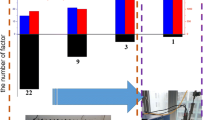Abstract
Seven amino acids were tested as precursors to affect pristinamycin production by a mutant strain derived from Streptomyces pristinaespiralis ATCC25486. Of those, glycine was selected as the best precursor to facilitate both cell growth and pristinamycin production at the feeding time of 36-h incubation and the feeding rate of 0.75 g L−1 flask culture. The optimized time and concentration of glycine feeding were applied to enlarged 3-L bioreactor fermentation with a resin added at the time of 20-h fermentation for in situ separation. As a result, a combination of the glycine feeding and the added resin resulted in the maximal pristinamycin yield of 616 mg L−1 culture 12 h after glycine feeding. The yield from the combined treatment was 1.71-, 2.77- and 4.32-fold of those from the mere glycine and resin treatments and the control, respectively. Other parameters, including intracellular nucleic acid content, animo nitrogen content and pH level, during 72-h fermentation were also given in association with the pristinamycin yields in the different treatments. The results indicate that glycine feeding is an effective approach to enhance pristinamycin production in the culture of S. pristinaespiralis F213 with supplemented resin for in situ separation.


Similar content being viewed by others
References
Preud’homme J, Tarridec P, Belloc A (1968) Isolation, characterization, and identification of the components of pristinamycin. Bull Soc Chim Fr 2:585–591
Leclercq R, Soussy CJ, Weber P, Moniot-Ville N, Dib C, Multicentrique GE (2003) In vitro activity of the pristinamycin against the isolated staphylococci in the French hospitals in 1999–2000. Pathol Biol 51:400–404
Ng J, Gosbell IB (2005) Successful oral pristinamycin therapy for osteoarticular infections due to methicillin-resistant Staphylococcus aureus (MRSA) and other Staphylococcus spp. J Antimicrob Chemother 55:1008–1012
Witte W, Naber K, Pasemann B, Cuny C, Klare I (1996) In vitro sensitivity of the pristinamycin combination RP 59500 against Staphylococci. J Chemother 5:17–22
Kingston DGI, Kolpak MX (1980) Biosynthesis of antibiotics of the Virginiamycin family. 1. Biosynthesis of Virginiamycin-M1: determination of the labeling pattern by the use of stable isotope techniques. J Am Chem Soc 102:5964–5966
Kingston DGI, Kolpak MX, Lefevre JW, Borupgrochtmann I (1983) Biosynthesis of antibiotics of the Virginiamycin family. 3. Biosynthesis of Virginiamycin-M1. J Am Chem Soc 105:5106–5110
Lefevre JW, Glass TE, Kolpak MX, Kingston DGI, Chen PN (1983) Biosynthesis of antibiotics of the Virginiamycin family. 2. Assignment of the C-13-Nmr spectra of Virginiamycin-M1 and antibiotic-A2315a. J Nat Prod 46:475–480
Casey JT, Walsh PK, O’Shea DG (2007) Characterisation of adsorbent resins for the recovery of geldanamycin from fermentation broth. Sep Purif Technol 53:281–288
Gluszcz P, Jamroz T, Sencio B, Ledakowicz S (2004) Equilibrium and dynamic investigations of organic acids adsorption onto ion-exchange resins. Bioprocess Biosyst Eng 26:185–190
Gu JL, Mu XQ, Xu Y (2010) Integration of newly isolated biocatalyst and resin-based in situ product removal technique for the asymmetric synthesis of (R)-methyl mandelate. Bioprocess Biosyst Eng 33:797–804
Lee JC, Park HR, Park DJ, Lee HB, Kim YB, Kim CJ (2003) Improved production of teicoplanin using adsorbent resin in fermentations. Lett Appl Microbiol 37:196–200
Nielsen DR, Amarasiriwardena GS, Prather KLJ (2010) Predicting the adsorption of second generation biofuels by polymeric resins with applications for in situ product recovery (ISPR). Bioresource Technol 101:2762–2769
Ribeiro MHL, Ribeiro IAC (2003) Modelling the adsorption kinetics of erythromycin onto neutral and anionic resins. Bioprocess Biosyst Eng 26:49–55
Wang XD, Tao JL, Wei DZ, Shen YL, Tong WY (2004) Development of an adsorption procedure for the direct separation and purification of prodigiosin from culture broth. Biotechnol Appl Bioc 40:277–280
Yu P, Dunn N, Kim W (2002) Lactate removal by anionic-exchange resin improves nisin production by Lactococcus lactis. Biotechnol Lett 24:59–64
Corvini P, Engasser JM, Vivier H, Germain P, Goergen JL (2000) Intracellular pH determination of Streptomyces pristinaespiralis by fluorescence ratio imaging. Abstr Pap Am Chem S 219:U215
Paquet V, Goma G, Soucaille P (1992) Induction of pristinamycins production in Streptomyces Pristinaespiralis. Biotechnol Lett 14:1065–1070
Voelker F, Altaba S (2001) Nitrogen source governs the patterns of growth and pristinamycin production in ‘Streptomyces pristinaespiralis’. Microbiol-Sgm 147:2447–2459
Jia B, Jin ZH, Lei YL, Mei LH, Li NH (2006) Improved production of pristinamycin coupled with an adsorbent resin in fermentation by Streptomyces pristinaespiralis. Biotechnol Lett 28:1811–1815
Omura S, Tsuzuki K, Tanaka Y, Sakakibawa H (1983) Valine is a precursor of n-butyrate unit in the biosynthesis of macrolide aglycone. J Antibiot 36:614–616
Tang L, Zhang YX, Hutchinson CR (1994) Amino-acid catabolism and antibiotic-synthesis—valine is a source of precursors for macrolide biosynthesis in Streptomyces ambofaciens and Streptomyces Fradiae. J Bacteriol 176:6107–6119
Omura S, Tanaka K, Mamada H (1984) Effect of ammonium ion, inorganic phosphate and amino acids on the biosynthesis of protylonolide: a precursor for tylosin aglycone. J Antibiot 37:494–502
Miao XS, March RE, Metcalfe CD (2003) Fragmentation study of salinomycin and monensin a antibiotics using electrospray quadrupole time-of-flight mass spectrometry. Rapid Commun Mass Spectrom 17:149–154
Li ZL, Wang YH, Chu J, Zhuang YP, Zhang SL (2009) Leucine improves the component of isovalerylspiramycins for the production of bitespiramycin. Bioprocess Biosyst Eng 32:641–647
Chen JM, Xu LT (1991) Analysis of Antibiotic Industry. Chinese Press of Pharmaceutical Science, Beijing
Schneider W (1945) Phosphorous compounds in animal tissues. 1, Separation and estimation of deoxypentose nucleic acid. J Biol Chem 61:293–295
Hammes W, Schleifer KH, Kandler O (1973) Mode of action of glycine on the biosynthesis of peptidoglycan. J Bacteriol 116:1029–1053
Acknowledgments
Funding of this study was supported by the National Natural Science Foundation of China (Grant No. 20976161) and the Natural Science Foundation of Ningbo City, China (Grant No. 2009A610149).
Author information
Authors and Affiliations
Corresponding authors
Rights and permissions
About this article
Cite this article
Zhang, LJ., Jin, ZH., Chen, XG. et al. Glycine feeding improves pristinamycin production during fermentation including resin for in situ separation. Bioprocess Biosyst Eng 35, 513–517 (2012). https://doi.org/10.1007/s00449-011-0624-x
Received:
Accepted:
Published:
Issue Date:
DOI: https://doi.org/10.1007/s00449-011-0624-x




